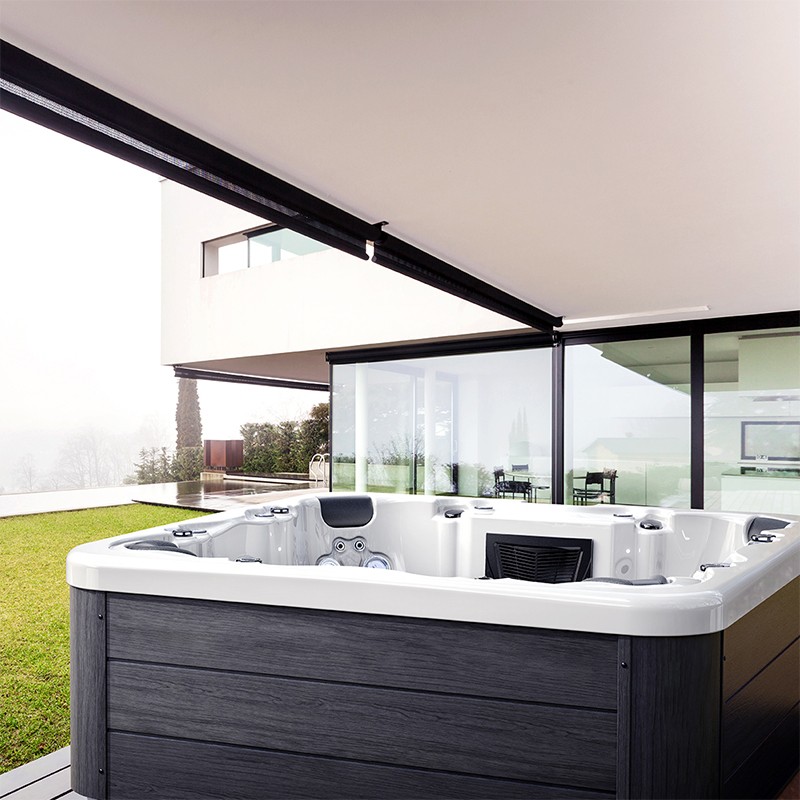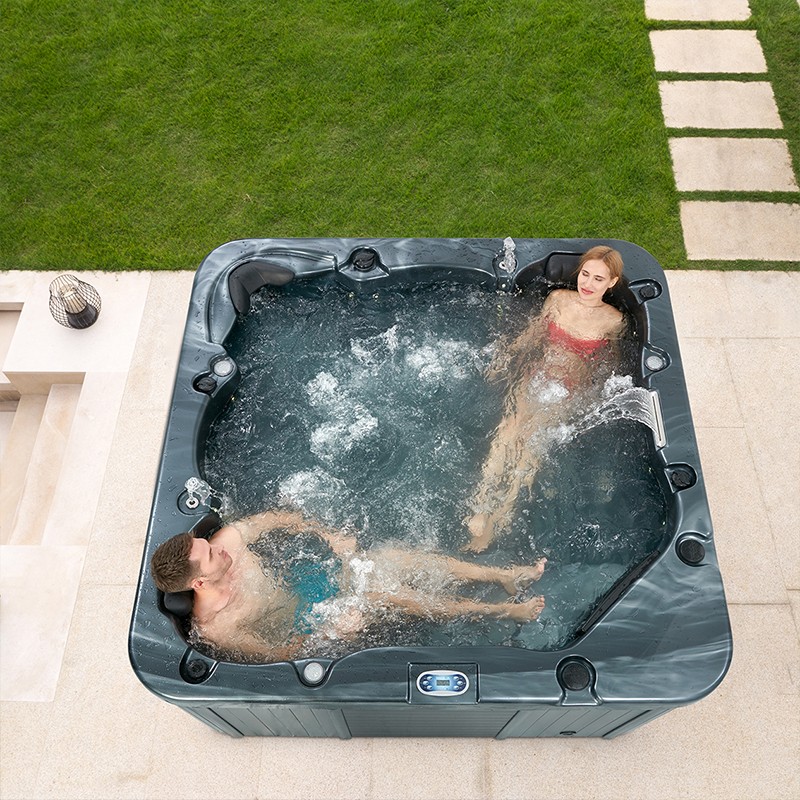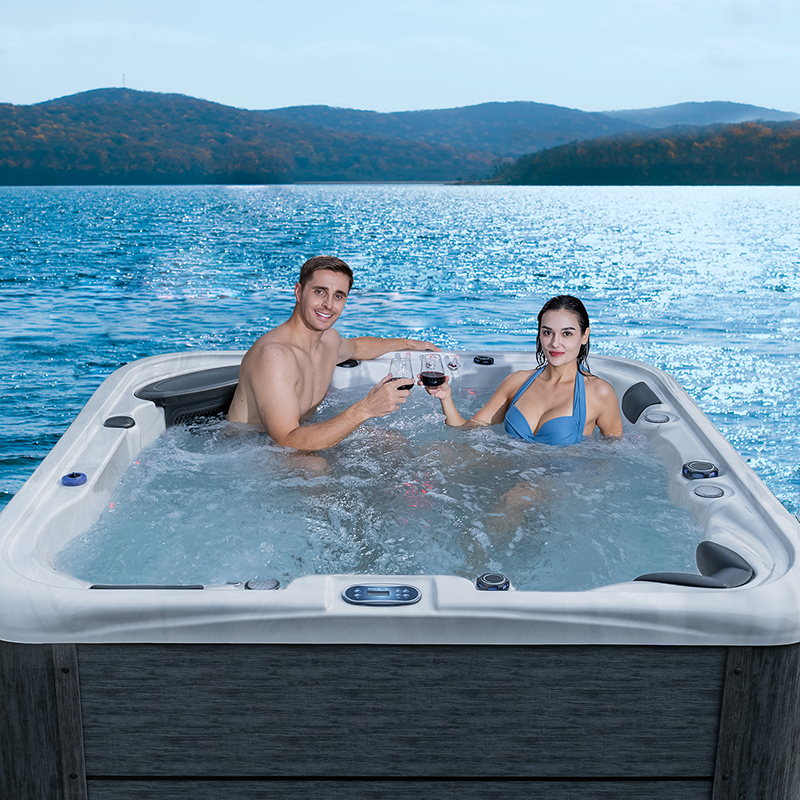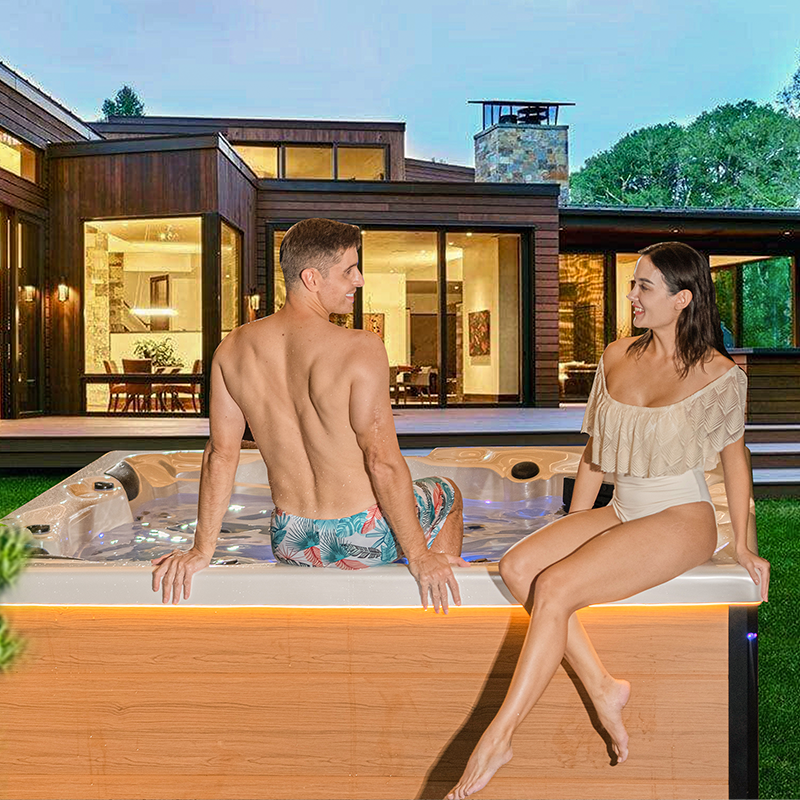
Can outdoor spa jacuzzi be used as rehabilitation equipment?
2025-07-19 15:35In the field of modern rehabilitation medicine and family health care, "non-drug intervention" and "physical therapy" have gradually attracted widespread attention. Among them, outdoor spa jacuzzi, with its multiple physical therapy mechanisms such as hot water, buoyancy, massage and hydrodynamics, is increasingly regarded as an effective auxiliary tool in the rehabilitation process.
Incorporating spa jacuzzi tub into a systematic rehabilitation plan is not as simple as "taking a hot bath", but a comprehensive plan involving human physiology, rehabilitation goal management, spa equipment configuration and frequency of use.
Starting from the principles of rehabilitation, this article will analyze in detail the feasibility and limitations of outdoor spa jacuzzi in the field of rehabilitation, and guide step by step how to formulate a scientific and feasible rehabilitation use plan for individuals or family members.

The relationship between outdoor spa jacuzzi and human rehabilitation
1. What is outdoor spa jacuzzi?
The outdoor spa jacuzzi is a multifunctional hot tub installed in an outdoor environment, integrating the following systems:
· Water heating system: maintains a constant and comfortable high-temperature water environment;
· Jet massage system: stimulates muscles and joints through high-pressure water flow;
· Bubble system: uses microbubbles to relax nerves and surface muscles;
· Water circulation and filtration system: ensures clean and safe water quality;
· Ergonomic seat/lying position design: ensures body support and relaxation;
· Adjustable control system: adjusts water temperature, water pressure, water flow direction and rhythm.
Compared with traditional bathtubs or ordinary hot water baths, outdoor spa jacuzzi has more sophisticated, active and controllable hydrotherapy functions, and can implement targeted stimulation and physical therapy for different physiological parts.
2. Is hydrotherapy effective for human rehabilitation?
The commonly used hydrotherapy mechanisms in rehabilitation medicine mainly include:
·Buoyancy: reduce joint load, suitable for bone and muscle injury recovery;
·Water pressure: promote blood and lymph circulation, reduce swelling and congestion;
·Thermal stimulation: relax muscles, relieve pain, and improve tissue stretchability;
·Dynamic water flow massage: enhance local muscle stimulation and reduce muscle tension;
·Nerve relaxation: reduce anxiety and promote parasympathetic nerve activity.
Combined with the above characteristics, outdoor spa jacuzzi has multiple rehabilitation and physiotherapy potentials, especially suitable for postoperative recovery, chronic joint pain, muscle tension, poor blood circulation, nervous system regulation and other fields.

What types of rehabilitation can use outdoor spa jacuzzi?
Not all rehabilitation projects are suitable for outdoor spa jacuzzi. According to its physiological characteristics, suitable rehabilitation types include:
1. Rehabilitation of skeletal muscle system
· Fracture rehabilitation period (activity training in the late stage of bone healing)
· Recovery of muscle strain and soft tissue contusion
· Rehabilitation of limited range of joint movement (such as frozen shoulder, hip and knee stiffness)
· Reducing mechanical load through buoyancy, combined with massage and thermal stimulation can increase joint flexibility and muscle relaxation.
2. Rehabilitation of nervous system
· Sequelae of stroke: water exercise promotes limb coordination and sensory recovery;
· Neurogenic dystonia;
· Symptom management of neuralgia, sciatica, etc.;
· Hot water and water flow massage can effectively relieve nerve tension and reduce the frequency of abnormal nerve discharge.
3. Rehabilitation related to blood circulation disorders
· Chronic venous insufficiency;
· Peripheral circulation disorders caused by diabetes;
· Lower limb edema, edema and other conditions;
· Improve blood return and tissue nutrition supply with the help of water pressure and water temperature stimulation.
4. Psychological-physiological rehabilitation
·Anxiety and stress syndrome;
·Mild sleep disorders;
·Dysfunction caused by autonomic nervous system disorders (such as chronic fatigue syndrome);
·Outdoor environment combined with hot water and massage can induce parasympathetic nerve activity, which helps to relax emotions and balance the nervous system.

Outdoor spa jacuzzi: Why is it important to formulate a rehabilitation plan?
1. Why can't you "take a bath casually" in the spa jacuzzi tub?
Rehabilitation intervention must be scientific and standardized. Random use of outdoor spa jacuzzi will not only fail to achieve the desired effect, but may aggravate certain symptoms, such as:
·Long-term high-temperature bathing causes hypotension and dehydration;
·Wrong water flow direction stimulates unhealed wounds;
·Abuse of massage function causes excessive muscle fatigue;
·High-frequency use leads to heat stress response and immune interference.
Therefore, it is the key to ensure efficacy and safety to formulate a reasonable use plan and control temperature, frequency, posture and water pressure.
Five principles for developing a rehabilitation plan:
· Guided by rehabilitation goals (such as pain relief, joint loosening, and emotional stability)
· Tailored to each person
· Follow the principle of gradualism
· Record feedback after each use
· Collaborate with rehabilitation doctors to evaluate and adjust
Outdoor spa jacuzzi: specific steps for developing a usage plan
Step 1: Assess rehabilitation needs and risks
Before starting, the following points should be clarified:
· Is the rehabilitation goal to relieve pain, promote activity, or regulate emotions?
· Are there contraindications to hydrotherapy such as hypertension, diabetes, and skin diseases?
· Are there metal implants, wounds, or postoperative recovery stages?
If you have a history of severe heart disease, infected wounds, or epilepsy, you should avoid or use the spa jacuzzi tub with caution.
Step 2: Set the appropriate water temperature and time
Recommended temperature range for spa jacuzzi tub:
| Purpose of use | Recommended water temperature (°C) |
| Mild muscle relaxation | 36–38°C |
| Deep tissue relaxation | 38–40°C |
| Improvement of blood circulation disorders | 39–41°C |
| Nerve regulation and emotional relief | 37–39°C |
Single use time of spa jacuzzi tub: should not exceed 30 minutes. Initially, it is recommended to use 15-20 minutes each time and adjust gradually.
Step 3: Determine the frequency of use
· Early stage of rehabilitation: 2-3 times per week;
· Stabilization or maintenance period: 1-2 times per week;
· Allow more than 24 hours for recovery each time;
· If you use the spa jacuzzi tub continuously for more than 3 weeks, you need to evaluate the effect and make adjustments.
Step 4: Choose the right body posture and water flow direction
· Sitting position: suitable for rehabilitation of the lower back, waist, and buttocks;
· Semi-lying position: suitable for full-body relaxation and nerve regulation;
· Alternating soaking and standing movement: suitable for lower limb strength and balance training.
Water flow angle recommendations:
· Spray on both sides of the spine to relax the back;
· Spray around the knees to relieve joint stiffness;
· Avoid continuous impact on the heart or abdomen.
Step 5: Record the effect and evaluate the adjustment
Create a usage log to record each time:
· Duration of use, temperature, and functional mode;
· Physical sensation after use (such as pain relief, muscle state);
· Recovery the next day (such as fatigue, sleep quality);
· Evaluate the effect every 3-4 weeks and adjust the parameters based on feedback.

Outdoor spa jacuzzi rehabilitation use plan details table
The following is a detailed table about the "outdoor spa jacuzzi as a rehabilitation equipment plan details table", covering key dimensions, including applicable population, rehabilitation goals, water temperature settings, frequency of use, recommended postures and precautions, etc., to facilitate systematic arrangement and management:
| Serial number | Rehabilitation type | Applicable people/symptoms | Rehabilitation goals | Recommended water temperature for spa jacuzzi tub (°C) | Frequency of spa jacuzzi tub use | Recommended postures | Precautions |
| 1 | Joint movement disorders | Scapulohumeral periarthritis, hip stiffness, knee joint postoperative recovery | Increase range of motion, relieve stiffness | 38–40°C | 3 times a week, 20 minutes each time | Half-lying or sitting | Avoid excessive water pressure on the affected area |
| 2 | Muscle injuries and chronic pain | Strain, back muscle strain, myofascial pain | Relieve tension, relax muscles | 37–39°C | 2–3 times a week | Half-lying, partial water flow massage | Control the high temperature time limit within 20 minutes |
| 3 | Nervous system regulation | Mild stroke sequelae, sciatica, neurogenic dystonia | Relieve nerve compression, improve coordination | 36–38°C | 2 times a week | Sitting + low water pressure massage | Do not allow water to flow directly to the midline of the spine or nerve damage |
| 4 | Blood circulation disorders | Lower limb edema, diabetic peripheral circulation disorder | Enhance blood return, eliminate edema | 39–41°C | 3 times a week | Sitting, foot water flow massage | No more than 25 minutes each time, use after properly lifting the legs |
| 5 | Postoperative recovery (non-acute phase) | Fracture recovery period, 3-4 weeks after soft tissue repair | Activate tissue function, reduce adhesions | 38–40°C | 2 times a week | Half-lying still + slight movement | Do not use the violent bubble mode, and require medical advice in the early postoperative period |
| 6 | Psychological and neurological regulation | Anxiety, stress, poor sleep | Relax nerves, help sleep | 37–38°C | Once every night or every other night | Lying flat and relaxing | Avoid using the same time period with stimulants such as caffeine and alcohol |
| 7 | Rehabilitation maintenance / chronic disease care | Chronic low back pain, degenerative arthritis, sub-health status | Improve overall comfort, slow down the degenerative process | 37–39°C | 1–2 times a week | Any comfortable posture | Long-term use should be combined with regular evaluation and cannot replace exercise and diet management |
✅ Additional suggestions:
·Recording tool suggestions: Use a rehabilitation diary app or form to record your feelings after each use of the spa jacuzzi tub.
·Periodic evaluation: It is recommended to review once every 4 weeks (self-evaluation or doctor's evaluation) to see if the plan needs to be adjusted.
·Water quality maintenance: Clean the spa jacuzzi tub filtration system and test the pH value every week to avoid skin sensitivity or infection.
What is your company’s experience in spa manufacturing?
Guangzhou HuanTong Industrial Co., Ltd. was established in 1989, making us one of the most experienced spa manufacturers in China. With over three decades in production, we have built a strong reputation as a high-quality, reliable supplier for global markets. We specialize in producing hot tubs, outdoor swim spas, and massage tubs for wholesale supply. Our factory spans 45,000 square meters and includes 200+ employees dedicated to delivering excellence.
